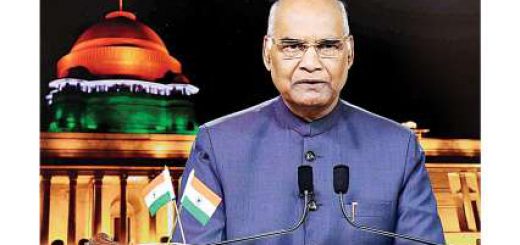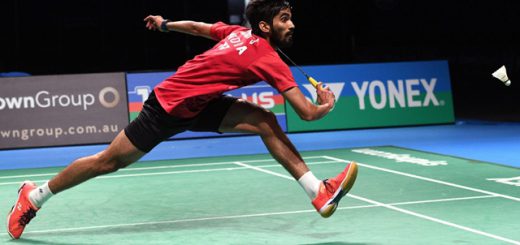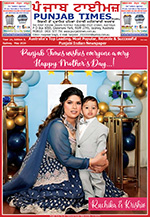Memories of Meals Past: For the Dalits in Maharashtra, the ban snaps their link to cheap protein
Lalita and son Sagar at their home (Source: Express photo by Prashant Nadkar)
By Anjali Lukose and Alifiya Khan
Tiny prawns have replaced the succulent beef, but a craving for the mouth-watering “kaali dal aani beef curry” or black lentils with beef curry refuses to go away.
It’s been a month since the Ingles, who work at the fishing dock at Bhaucha Dhakka or ferry wharf in South Mumbai’s Carnac Bunder, tasted their mother’s signature dish. The ban on slaughter of bulls and bullocks in the state and the self-imposed ban on slaughter of water buffaloes by beef dealers meant that the Ingles could find no beef anywhere. This, despite living across one of Asia’s largest abattoirs in Deonar, central Mumbai.
A beef recipe that Lalita Ingle picked up from her grandmother is the family’s favourite. “Thodi kalimari, kuch garam masala. Uska correct mix mein hi beef ka mast taste aata hai (Some pepper, some garam masala. The correct mix is the secret to the yum beef curry),” says Lalita, who is in her mid-40s. “Marinate the meat properly and cook it well but not in excess oil and then mix it with dal and it tastes almost as good as when my aaji (grandmother) used to make it,” she says. Lalita, her husband and three children, all working at the docks, live in the Bhim Sevak Sangh Mohala, Deonar.
For 12 hours a day, seven days a week, 60-year-old Pune resident Suman Ratikar, a ragpicker by profession, goes house to house picking wet waste from dry waste with her bare hands, cleaning verandahs for an extra five rupees and often ends up having to lift soiled diapers. Two days a week, she keeps a fast, which she breaks with chapati and a dry gravy made of beef innards.
Both the Ingles and Ratikars are a part of a food culture that is as old as any other in India. In 2009, a team of researchers from the University of Pune embarked on a project to unearth the food memories of Dalits. “Yes, beef-eating is an intrinsic part of Dalit culture and has been a major source of protein for the community for ages. But it’s important to understand whether this was a choice or food economics that forced the community to eat beef. The basic idea was to untangle the caste, class and gender dynamics of the food we eat,” says Sangita Thosar, a teaching associate at the Tata Institute of Social Sciences, Mumbai, and a Dalit. She was a part of the editorial team of Isn’t This Plate Indian? Dalit Histories and Memories of Food, the result of the project which was led by the late sociologist Sharmila Rege.
The aim of the project was not just to show how deprivation determined Dalit food habits, but also to explore the cuisine’s creativity, its ability to make the most of its frugality. For example, chunchuni is dried and salted beef which is stored sometimes for an entire year, and consumed when families have no money to buy vegetables. Kandawani is a dish made with only onions, with a similar philosophy: to be made when nothing else is available. “Rakti might sound gross to you but is quite nutritious. It is made of coagulated chunks of cattle blood. No part of the animal was wasted,” says Thosar, whose family is from Rohkal village in Osmanabad district’s Paranda Taluka, and who belongs to the Mahar community. Dalits possess their own distinct culinary traditions, she says, but they never figure in any cookbooks, “which only mention upper-caste recipes”.
The book acknowledges that food was central to the concept of untouchability as the Brahminical order first decided who would eat what, and later made it a mark of pure and impure status.
The probable history of why Dalits took to beef lies in the upper-caste Hindu’s aversion to meat as he began to afford a range of vegetables and dairy products. For Dalits, who couldn’t buy richer meats like chicken or mutton, beef remained a staple. “Often it would be the dried meat of dead and decaying cattle. One cooked liver or innards which came at one-third the price. These are fatty portions and require less oil to cook too. For a woman like Ratikar, who gets Rs 50 a day can only spend Rs 40 once in a week to buy beef innards, any other meat is unthinkable,” says Thosar.
The Ingles live in a mixed colony. Here, the mostly fisherfolk Dalit community cohabit with the Qureshi butchers and meat handlers working at the abattoir across the street. The Ingles would buy beef twice a week, mostly at a discounted rate, from their neighbours. While the market rates were Rs 140 a kg, the Ingles would get fresh beef from the abattoir at Rs 100 a kg.
“We bought beef, because it is tastier and relatively cheaper,” says Lalita, who sells fish at the docks. “Now, we bring home more prawns and Bombay Duck to compensate,” she says. More than the dish, the Ingles say, the grim mood at their neighbours’ makes them wish the ban would be repealed. “Chalo, in desperation, we can manage with dal-chawal also. But for our friends, it is a question of their livelihood,” says Sagar Ingle, Lalita’s 22-year-old son.
Thosar believes the ban on beef (except meat from water buffaloes) in Maharashtra will spell disaster for the community. “Imagine the chief protein source vanishes from your diet. Soon prices of water buffalo will go up too. Will they be able to afford it?” she says.
But April 1 was a special day for the Ingles. Their neighbours and close friends were back on duty at the abattoir. “It’s twice the excitement today. Our neighbours have got their jobs back and we will get beef tonight,” says Sagar, referring to the Qureshi community returning to their jobs, this time culling only water buffaloes. “Just yesterday, my father who cannot live without beef, planned to go to Mumbra. He heard they were selling beef there. Legal or illegal, my father did not care. That’s how much he misses it,” he says.
For one night, at least, the smell of beef curry would waft through this lane.
Source:: Indian Express





